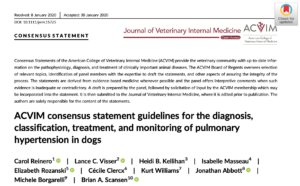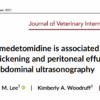
The LINK for the Open Access Consensus Statement is here. To summarize some of the major points:
- Gold Standard Test is a right heart catheter similar to a Swan-Ganz catheter, however, the catheterization procedure is invasive with risk so most diagnoses rely on less invasive imaging via echocardiography. Echocardiography is prone to inaccuracies for several reasons. This is important to realize because echocardiography is based on assumptions and equations that provide indirect assessment for PH and its degree. See below for echocardiography findings that support PH.
- Pulmonary Hypertension (abbreviated PH or PHT) is often missed because it is not at the top of the differential in many respiratory distress cases.
- You should be considering PH as a strong possibility in the differential in these cases:
- Syncope especially with exertion or activity – ACVIM Consensus Statement
- Respiratory distress at rest – ACVIM Consensus Statement
- Activity or exercise terminating in respiratory distress – ACVIM Consensus Statement
- Right-sided congestive heart failure (cardiogenic ascites) – ACVIM Consensus Statement
- Radiographic pulmonary changes that don’t fit the level of respiratory signs-distress (walks 10 steps and becomes cyanotic) – FASTVet Addition
- You should be considering PH as suggestive in the differential in these cases:
- Tachypnea at rest
- Increased respiratory effort at rest
- Prolonged postexercise or post-activity tachypnea
- Cyanotic or pale mucus membranes
- Pulmonary Hypertension (abbreviated as PH or PHT) is a syndrome due to different types of diseases that have 3 major categories as causes:
- 1) Increased pulmonary blood flow (ASD, VSD, PDA, aortopulmonary window)
- Congenital left to right shunting
- Extra-cardiac defects
- 2) Increased pulmonary vascular resistance (pre-capillary hypertension) due to pulmonary arterial disease either direct or indirect
- Pulmonary endothelial dysfunction
- Pulmonary vascular remodeling
- Perivascular inflammation
- Vascular luminal obstruction, PTE (pulmonary thromboembolism)
- Increased blood viscosity
- Arterial wall stiffness
- Lung parenchymal destruction
- 3) Increased pulmonary venous pressure (post-capillary hypertension) due to pulmonary venous disease either direct or indirect
- Left-sided congestive heart failure/disease
- Compression of a large pulmonary vein
- 1) Increased pulmonary blood flow (ASD, VSD, PDA, aortopulmonary window)
- Echocardiography findings that support PH that are recognizable using *TFAST® and the Global FAST® Approach using the 3 sites defined in the ACVIM PH Consensus Statement
- Anatomic Site 1 – Ventricles
- Flattening of the interventricular septum
- Right ventricular (RV) enlargement or RV hypertrophy or both
- Anatomic Site 2 – Pulmonary artery (PA)
- PA/Ao is > 1:1
- Anatomic Site 3 – Right atrium (RA) and caudal vena cava (CVC)
- Enlargement of the RA
- Enlargement of the CVC
- Anatomic Site 1 – Ventricles
*These findings on TFAST® and Global FAST® trigger a complete detailed echocardiogram by a cardiologist
-
- Additional important information
- TFAST® echo view and the LA:Ao Ratio
- TFAST® and the presence of intracardiac heartworms (Dirofilaria immitis)
- AFAST® the presence of ascites (modified transudate)
- Additional important information
Watch our February 9th Webinar on Pulmonary Hypertension for images of many of the findings listed above – click here.




